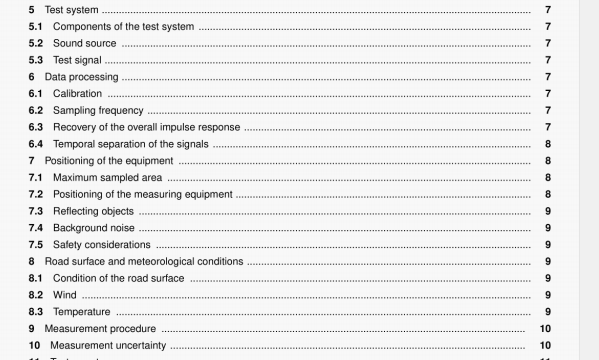ISO 13472-1 pdf download – Acoustics-Measurement of sound absorption properties of road surfaces insitu一 Part 1: Extended surface method.
5.1 Components of the test system
The test equipment shal comprise an electroacoustic system. consisting of an electronic signal generator, a power amplifier and a loudspeaker, a microphone with ampM,er and a signal analyser capable of perlorming cross correlation and transformations between the time and the frequency domains.
A sketch of the essential components of the measuring system is shown in Figure 1.
The complete measuring system shall meet the requirements of at least a type 2 instrument in accordance with IEC 60651. For the purposes of this part of ISO 13472, the measurement frecpiency range is displayed in one-ttrdoctave bands, from 250 Hz to 4 kHz.
5.2 Sound source
The loudspeaker shall
— have either a single or a coaxial cone in a closed cabinet, and
— have a smooth frequency response without sharp irregularities throughout the measuremenl frequency range, resulting in an impulse response under free.lield conditions with a length not greater than 2 ms.
5.3 Test signal
The test signal shall consist of a repeatable short signal with a low peak-to•RMS ratio, typically below 2, and an energy content that covers the one-thirdoctave bands from 250 Hz up to 4 kHz with an acceptable S/N ratio. Several signals may be used, such as maxrnum4ength sequences (MLS. see annex 0) or short trecpjency sweeps.
6 Data processing
6.1 Calibration
The measireinent procetur oisibed in this part of ISO 13472 is based on extracted from the same electroacoustical chain. An absolute calibration of the measurement chain with regard to the sound pressure level is, therefore, unnecessary. However, a reference measurement as described in annex B is required.
6.2 Sampling frequency
The subtraction principle implies knowledge of the exact waveform, especially for checking change of time delays in the measurement chain. The sarrling Irequency f shall therefore have a value greater than 40 kHz.
NOTE Although the signal Is already unambiguously defined v.ten the Nyquisi ciitenon is met. Igher sampling frequencies lacilitate a dear reproduction at the signal. Errors can be detected and corrected more easily, such as corrections needed to account for time ehifta due to teniperalure changes.
6.3 Recovery of the overall impulse response
The overall impulse response is obained through a cross-correlation between the electronic source signal and the received microphone signal (see annex D).
h) Record the free-field impulse response with the measurement set-up removed from any reflecting surface which could influence the measurement and keeping the same geometrical configuration (see 4.2).
i) Isolate the impulse response of the reflected path using the signal subtraction technique. Parasitic reflections are cancelled by a suitable temporal window (see 6.4).
j) Multiply the direct impulse resonance and the reflected impulse resonance with a temporal window and compute the power spectra of the two signals extracted using time windows by means of Fourier transform. If it is necessary to calculate the complex reflection factor, the complex spectra should be used.
k) Compute the sound power reflection factor (see 4.1 and annex C). taking into account the geometrical spreading factor as specified in 4.1.
I) Repeat the whole procedure from point a) to point k) on a highly reflective reference surface, and apply the procedure specified in annex B.
m) Compute the road surface sound absorption coefficient by linear averaging narrow band absorption in one-third- octave bands (see 4.1 and annex B).
n) If necessary. repeat measurements at different points on the road surface.
0) Write a measurement report (see clause 11 and also annex E).
10 Measurement uncertainty
The accuracy in the outcome of the measurement is limited due to several factors as follows.
a) The zeroing out of the direct response will not be perfect. leading to a small but significant error.
b) The reference surface will not be perfectly reflecting, especially when a portable construction is used.
c) The measurement chain will not be absolutely stable, leading again to non-perfect zeroing of the direct response.
d) Determination of the geometrical spreading factor K is implicitly based on the reference measurement situation with a reflective surface. In the case of thick absorptive surfaces, the plane of reflection is not unambiguously defined, which will lead to an underestimate of the reflection factor.
ISO 13472-1 pdf download – Acoustics-Measurement of sound absorption properties of road surfaces insitu一 Part 1: Extended surface method
